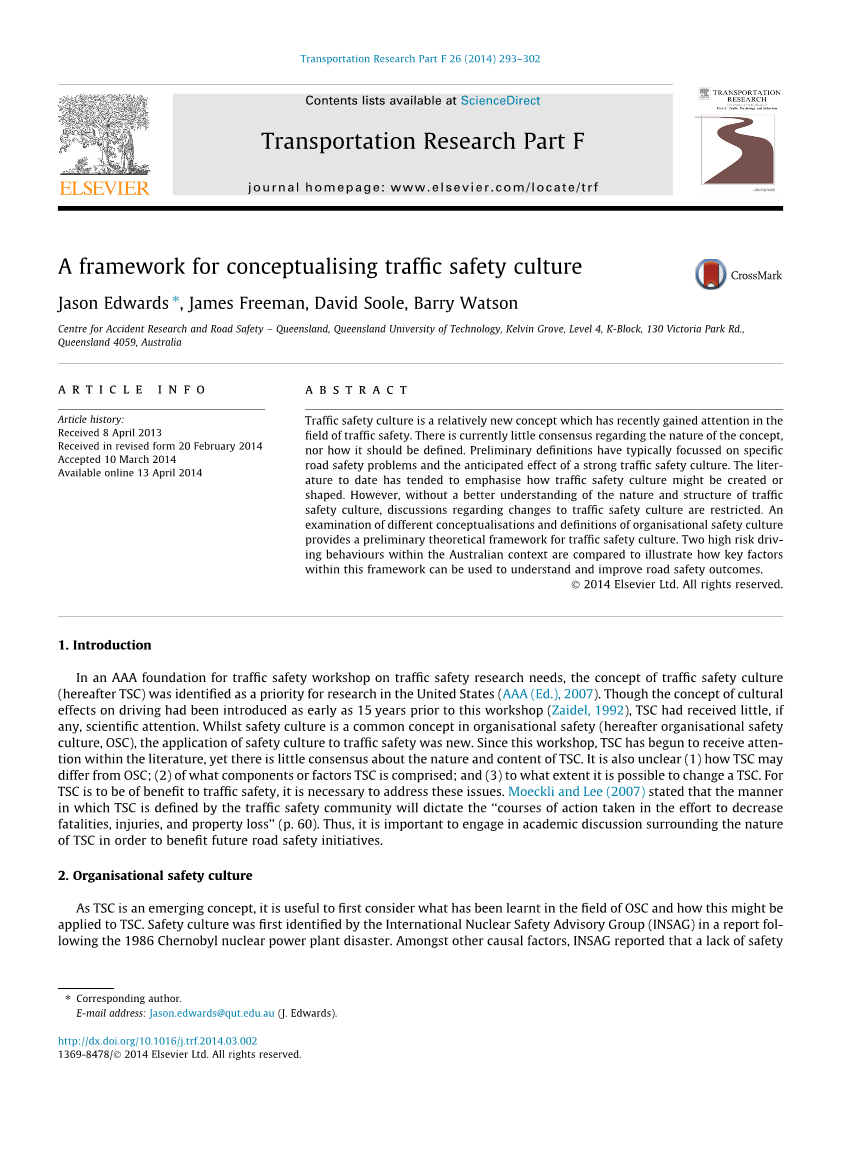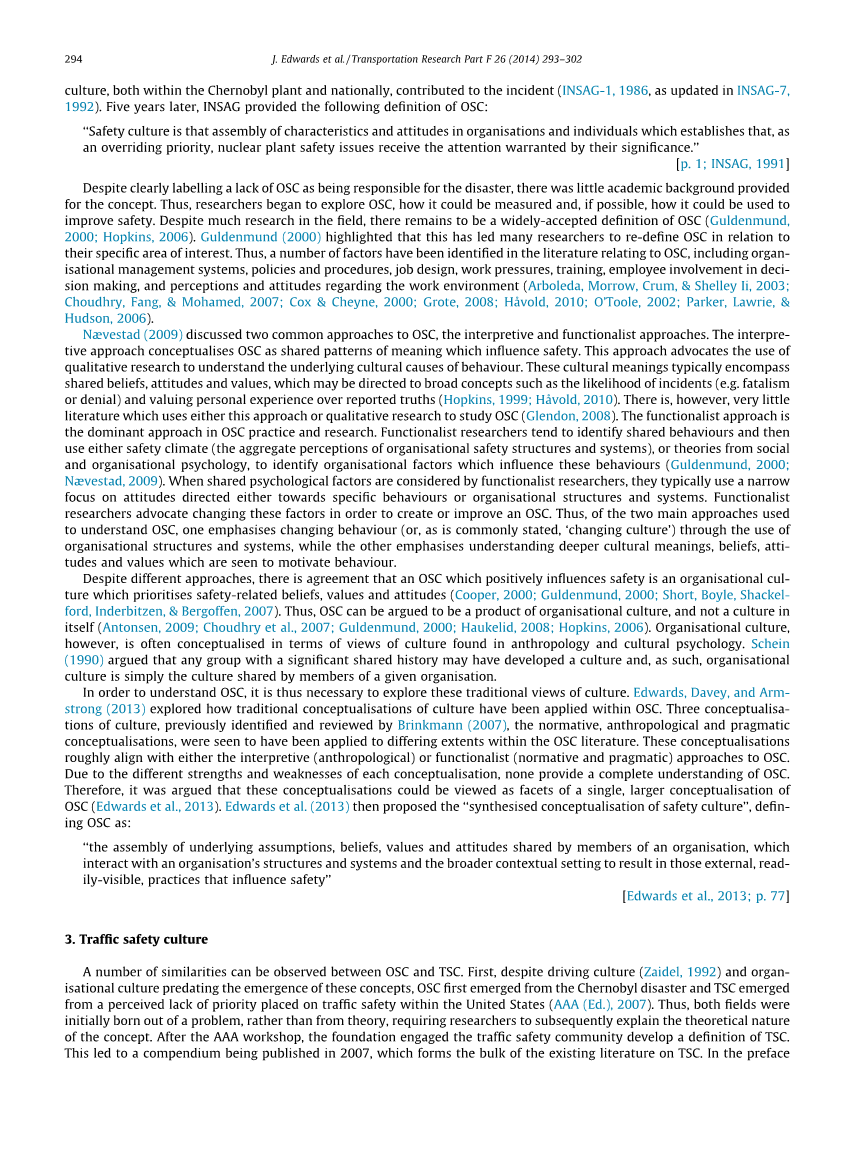中国城市交通安全文化缺失成因及重构策略研究外文翻译资料
2022-10-14 18:50:56


英语原文共 10 页,剩余内容已隐藏,支付完成后下载完整资料
A framework for conceptualising traffic safety culture
Jason Edwards , James Freeman, David Soole, Barry Watson
Transportation Research Part F
1. Traffic safety culture
A number of similarities can be observed between OSC and TSC. First, despite driving culture (Zaidel, 1992) and organisational culture predating the emergence of these concepts, OSC first emerged from the Chernobyl disaster and TSC emerged from a perceived lack of priority placed on traffic safety within the United States (AAA (Ed.), 2007). Thus, both fields were initially born out of a problem, rather than from theory, requiring researchers to subsequently explain the theoretical nature of the concept. After the AAA workshop, the foundation engaged the traffic safety community develop a definition of TSC. This led to a compendium being published in 2007, which forms the bulk of the existing literature on TSC. In the preface of the compendium, a number of statements were made regarding the TSC of the United States, which serve as the earliest descriptions of TSC. It was suggested that, despite 43,000 fatalities each year, there is a general failure to appreciate “the full implications of these tragedies”, and a lack of implementation of proven traffic safety countermeasures able to halve the annual number of fatalities (AAA, 2007). The prevailing TSC in the United States was described as “a culture that accepts loss of life and limb as a price of mobility” (p. ii; AAA, 2007). From these descriptions, the perceived problem which provided the impetus for investigating TSC appears to have been a prevailing acceptance of fatalities, a level of inaction despite viable intervention options being available, and a sense of fatalism. In many ways, this mirrors the INSAG description of a lack of safety culture surrounding the nuclear power industry and the need for safety to receive the attention warranted by its significance (INSAG-4, 1991).
Throughout the AAA compendium, significant discussion focussed on strategies for changing a TSC. This resembles functionalist approaches to OSC, which emphasises improving safety by changing OSC. However, little attention was given to defining TSC, and only a small number of indirect definitions were provided in the compendium. McNeely and Gifford (2007) indicated that TSC is an aspect of the larger culture within which driving occurs. For this reason, they argued that traffic safety interventions generally aim to alter the norms, attitudes and actions governing traffic safety. Moeckli and Lee (2007) highlighted the relationship between national cultural values and traffic safety, linking cars to the American values of freedom, individualism, self-realisation, prosperity and progress. They provided a “common” definition of culture as consisting of “the beliefs, values, norms and things people use, which guide their social interactions in everyday life” (Moeckli amp; Lee, 2007; p. 62). Thus, TSC consists of elements of national culture which influence traffic safety. Given that OSC is also linked to traditional views of culture, TSC and OSC are arguably be based upon the same theoretical principles.
Lonero (2007) defined two concepts that were suggested to relate to TSC. The first was road safetyrsquo;s cultural paradigm, consisting of “the implicit shared values and beliefs that determine the way in which the society organizes and acts to assure safe, sustainable mobility” (p. 14). The second was driving culture, consisting of “common practices, expectations, and informal rules that drivers learn by observation from others in their communities” (Lonero, 2007; p. 7). Despite the distinction between these concepts, both share the core elements of beliefs, attitudes and values.
The TSC descriptions and definitions above appear to rely heavily upon an interpretive approach to culture, through emphasising shared beliefs, attitudes and values which are argued to motivate behaviour. However, within the OSC literature, interpretive-based definitions are common and it is predominantly in the transfer to research and practice that an emphasis on organisational factors emerged. That is, though OSC is typically defined using interpretive frameworks, it is commonly operationalized in a functionalist manner. Thus it is worth noting the few AAA compendium papers which began to lay the foundation and aims for future research.
Whilst advocating the goal of improving safety by changing TSC, Allen and Mercer (2007) suggested that it was necessary to first understand the existing culture. It was argued that, in order for public education to be a beneficial tool for change, it is first necessary to understand what the public already knows, believes and values. Girasek (2007) also emphasised the importance of identifying shared beliefs, attitudes and values which are in opposition to improved road safety, including beliefs regarding the effectiveness and appropriateness of government spending on further road safety initiatives, and the belief that crashes are caused by carelessness or stupidity. A number of potential factors were suggested to contribute to these beliefs, ranging from political ideology to personal biases in the perceived likelihood of an incident. By exploring and identifying the attitudes, beliefs, or biases that are in opposition to evidence-based safety initiatives, it was argued that researchers could develop strategies to best to improve traffic safety. Thus, these two papers align with the interpretive approach to OSC, by emphasising shared beliefs, attitudes and values, rather than structures and systems.
In addition to the AAA compendium, Girasek (2011) has taken a first step towards operationalising and measuring TSC. However, from his working definition of a positive TSC as “a social climate in which traffic safety is highly valued and rigorously pursued”, and in the factors which were identified, this study can be view
剩余内容已隐藏,支付完成后下载完整资料
资料编号:[151262],资料为PDF文档或Word文档,PDF文档可免费转换为Word




